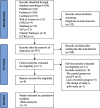Efficacy of home phototherapy versus inpatient phototherapy for neonatal hyperbilirubinemia: a systematic review and meta-analysis
- PMID: 38433210
- PMCID: PMC10910825
- DOI: 10.1186/s13052-024-01613-0
Efficacy of home phototherapy versus inpatient phototherapy for neonatal hyperbilirubinemia: a systematic review and meta-analysis
Abstract
Background: Home phototherapy (HPT) remains a contentious alternative to inpatient phototherapy (IPT) for neonatal hyperbilirubinemia. To guide evidence-based clinical decision-making, we conducted a meta-analysis of randomized clinical trials (RCTs) and cohort studies and assessed the comparative risks and benefits of HPT and IPT.
Methods: PubMed, Embase, Web of Science, Cochrane Library, Chinese National Knowledge Infrastructure Database, Wanfang Database, Chinese Science and Technique Journals Database, ClinicalTrials.gov, and International Clinical Trial Registry Platform trial were searched from inception until June 2, 2023. We included RCTs and cohort studies and adhered to Preferred Reporting Items for Systematic Reviews and Meta-Analysis guidelines. Study quality was assessed with the Cochrane Collaboration Risk of Bias tool and the Newcastle-Ottawa scale. The outcome measures were phototherapy duration, daily bilirubin level reduction, exchange transfusion, hospital readmission, parental stress scale, and complications. We used fixed- or random-effects meta-analysis models, assessed heterogeneity (I2), conducted subgroup analyses, evaluated publication bias, and graded evidence quality.
Results: Nine studies (998 patients) were included (four RCTs, five cohort studies). HPT was associated with longer phototherapy duration (SMD = 0.55, 95% CI: 0.06-1.04, P = 0.03). Cohort study subgroup analysis yielded consistent results (SMD = 0.90; 95% CI: 0.69 to 1.11, P < 0.001, I2 = 39%); the RCTs were not significantly different (SMD = -0.04; 95% CI: -0.15 to 0.08, P = 0.54, I2 = 0%). Hospital readmission was higher with HPT (RR = 4.61; 95% CI: 1.43-14.86, P = 0.01). Daily bilirubin reduction (WMD = -0.12, 95% CI: -0.68 to 0.44, P = 0.68) or complications were not significantly different (RR = 2.29; 95% CI: 0.31-16.60, P = 0.41). The evidence quality was very low. HPT was associated with lower parental stress (SMD = -0.44, 95% CI: -0.71 to -0.16, P = 0.002). None of three included studies reported exchange transfusion.
Conclusions: The current evidence does not strongly support HPT efficacy for neonatal hyperbilirubinemia, as high-quality data on long-term outcomes are scarce. Future research should prioritize well-designed, large-scale, high-quality RCTs to comprehensively assess HPT risks and benefits.
Keywords: Efficacy; Home phototherapy; Meta-analysis; Neonatal hyperbilirubinemia.
© 2024. The Author(s).
Conflict of interest statement
The authors declare that they have no competing interests.
Figures
Similar articles
-
Fluid supplementation for neonatal unconjugated hyperbilirubinaemia.Cochrane Database Syst Rev. 2017 Aug 1;8(8):CD011891. doi: 10.1002/14651858.CD011891.pub2. Cochrane Database Syst Rev. 2017. PMID: 28762235 Free PMC article.
-
Periodic change of body position under phototherapy in term and preterm neonates with hyperbilirubinaemia.Cochrane Database Syst Rev. 2022 Mar 2;3(3):CD011997. doi: 10.1002/14651858.CD011997.pub2. Cochrane Database Syst Rev. 2022. PMID: 35235686 Free PMC article.
-
Case management approaches to home support for people with dementia.Cochrane Database Syst Rev. 2015 Jan 5;1(1):CD008345. doi: 10.1002/14651858.CD008345.pub2. Cochrane Database Syst Rev. 2015. PMID: 25560977 Free PMC article.
-
Transcutaneous bilirubinometry for detecting jaundice in term or late preterm neonates.Cochrane Database Syst Rev. 2024 May 28;5(5):CD011060. doi: 10.1002/14651858.CD011060.pub2. Cochrane Database Syst Rev. 2024. PMID: 38804265 Free PMC article.
-
Treatment for women with postpartum iron deficiency anaemia.Cochrane Database Syst Rev. 2024 Dec 13;12(12):CD010861. doi: 10.1002/14651858.CD010861.pub3. Cochrane Database Syst Rev. 2024. PMID: 39670550
Cited by
-
How to select the correct patients for home phototherapy of neonatal hyperbilirubinaemia-a retrospective population-based implementation study.Eur J Pediatr. 2025 Jul 31;184(8):515. doi: 10.1007/s00431-025-06353-9. Eur J Pediatr. 2025. PMID: 40745041 Free PMC article.
-
First in-human pilot study of wearable phototherapy for neonatal hyperbilirubinaemia.Eur J Pediatr. 2025 Jun 9;184(7):407. doi: 10.1007/s00431-025-06239-w. Eur J Pediatr. 2025. PMID: 40488806 Free PMC article.
-
Review of Precision Medicine and Diagnosis of Neonatal Illness.Diagnostics (Basel). 2025 Feb 16;15(4):478. doi: 10.3390/diagnostics15040478. Diagnostics (Basel). 2025. PMID: 40002629 Free PMC article. Review.
-
Home phototherapy for neonatal hyperbilirubinemia: a mixed methods systematic review and meta-analysis.Pediatr Res. 2025 Jul 26. doi: 10.1038/s41390-025-04313-5. Online ahead of print. Pediatr Res. 2025. PMID: 40715357
References
-
- National Institute for Health and Care Excellence: Guidelines. Jaundice in newborn babies under 28 days, 2016. https://www.nice.org.uk/guidance/cg98. Accessed 20 Jul 2023. - PubMed
Publication types
MeSH terms
Substances
LinkOut - more resources
Full Text Sources




